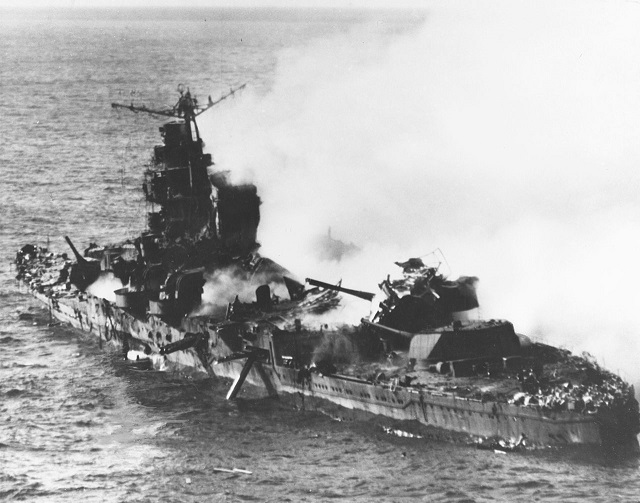Battle of Midway Remembered 75 Years On
One of the most important battles in U.S. naval history, the Battle of Midway was the turning point in World War II’s Pacific Theater. 75 years ago, on June 4, 1942, the fate of the Pacific rested on the shoulders of U.S. sailors at Midway.
The Pacific Theater
In the wake of the Japanese surprise attack on Pearl Harbor on December 7, 1941, the U.S. was at war with Japan. By early 1942, the Japanese were continuing to flex their naval might, seeking to target Navy carriers not destroyed at Pearl Harbor and keen on eliminating the Navy presence and threat in the Pacific.
Determined to stop that momentum and break out of a primarily defensive mode, the Navy intensified its intelligence gathering efforts and zeroed in on Japanese communications. Progress to this end was on display by mid-April when the Navy teamed with the Army to launch the proactive Doolittle Raid on Japan’s home islands, and then again a few weeks later, when the Navy held their own in the Battle of Coral Sea. This was the first carrier-based fight of the war – a new type of engagement where opposing ships never actually saw or directly fired upon one another.
The showdown at Midway was on the horizon.
A Secret Advantage
What helped the U.S. Navy gain the upper hand in the Pacific more than anything else was its ability to know what its enemy was planning to do before they did it. This advantage came from the critical work of dedicated Navy code breakers – particularly those associated with the Combat Intelligence Unit in Pearl Harbor known as HYPO.
Leading up to Midway, they were on a relentless quest to crack the complex Japanese JN-25 code, which carried the opposition’s most secure communications. Messages were routinely intercepted and exhaustively analyzed with mathematical, technical and creative skill.
By March of 1942, the code was finally broken – essentially giving access to the Japanese playbook of planned operations. Having secretly taken away the Japanese element of surprise, the Navy was able to shift to the offensive and, at Midway, turn a planned ambush by the enemy into one of its own.
The Significance of Midway
Midway, a small atoll in the middle of the Pacific, was a location of strategic importance for both sides. Approximately 1300 miles northwest of Pearl Harbor and close to halfway between Japan and the West Coast of the U.S., Midway was already the site of a Navy base.
The Japanese goal was to attack Midway, capture it and use it as an advance base that would establish an eastern shield for its own Pacific operations. They knew the U.S. would defend it with all available resources and hoped to lure the Navy carriers and fleet into a trap. But the U.S. knew of the plan and were ready to deploy its three aircraft carriers and supporting ships, submarines and aircraft accordingly.
_is_hit_by_a_torpedo_on_4_June_1942.jpg) USS Yorktown at the moment of impact of a torpedo.
USS Yorktown at the moment of impact of a torpedo.
Timeline
June 2, 1942 – Navy carriers, aircraft, ships and personnel take their positions on and around Midway
June 3, 1942 – Initial sightings of Japanese forces en route to Midway are reported
June 4, 1942 – Japanese planes begin bombing Midway around first light; successive waves of counterattacks by American torpedo planes and bombers are launched; the four Japanese carriers (Akagi, Kaga, Soryu and Hiryu) are bombed and sunk or sinking by day's end; the Navy carrier USS Yorktown is seriously damaged but does not go down
June 5, 1942 – Remaining elements of the Japanese fleet are pursued westward; salvage work on the now-in-tow USS Yorktown is underway
June 6, 1942 – Navy air attacks conclude; the USS Yorktown, its crew off board but still being towed by Navy fleet forces, is mortally torpedoed by Japanese submarines
June 7, 1942 – Though the USS Yorktown finally succumbs to its damages and is sunk, the battle is considered a victory for the U.S.
Leadership
Extraordinary contributions were made by thousands of U.S. sailors. Admirals Chester W. Nimitz, Raymond A. Spruance, William Frederick Halsey, Jr., and Frank Jack Fletcher together commanded and led the battle. Code breaker and Captain Joseph John Rochefort led the team that broke the Japanese JN-25 code. Aviator and Ensign George Henry Gay, Jr. was the sole survivor of Torpedo Squadron 8. Aviator and Captain Clarence W. McClusky led the air group scout bombers that sunk two of the Japanese carriers.
Submariner and Lieutenant Commander John W. "Spuds" Murphy of the USS Tambor (SS-198) managed to damage two Japanese ships without firing a torpedo. During the mid watch on June 5, 1942, ignorant of the location of friendly forces, Murphy spotted four ships on the horizon that proved to be four Japanese heavy cruisers. When carrying out emergency evasive maneuvers, two of the enemy ships, Mikuma and Mogami, collided.
 Sinking of the Japanese cruiser Mikuma.
Sinking of the Japanese cruiser Mikuma.

that matters most
Get the latest maritime news delivered to your inbox daily.
CNO Speech
The U.S. Chief of Naval Operations Adm. John Richardson has delivered a speech in honor of the 75th Battle of Midway Anniversary from the deck of USS Midway Museum. A podcast includes the Navy Hymn and Taps.
